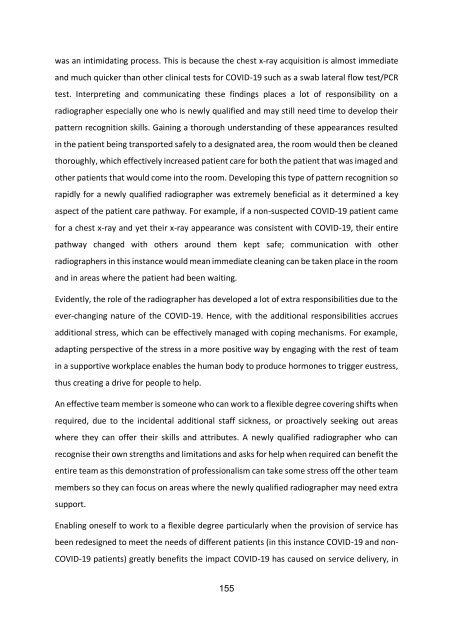ISRRT_COVID-19_book
You also want an ePaper? Increase the reach of your titles
YUMPU automatically turns print PDFs into web optimized ePapers that Google loves.
As the majority of these patients required hospital treatment, most were admitted to the<br />
wards, and the patients who had become acutely unwell/deteriorated would need urgent<br />
chest imaging. As these patients were too unwell to come down to the department, the<br />
inevitable result was an increase in the number of mobile examination requests.<br />
Working in an extremely busy NHS Trust in the North West of England, in a profession that is<br />
nationally recognised as being short staffed, can affect ones mental and physical health.<br />
Coupling that issue with a disease that had manifested itself across the world did not just<br />
result in uncertainty regarding its transmission but it also added to the mental and physical<br />
stress that had been transmitted to frontline healthcare professionals. Radiographers had to<br />
try to cope with the ever-increasing workflow, for example, the number of mobile chest x-ray<br />
examinations as it was unsafe for most of these patients to be transported and x-rayed in the<br />
department. One solution to tackling this sudden increase in workload was to send more than<br />
one radiographer on a confirmed <strong>COVID</strong>-<strong>19</strong> portable chest x-ray procedure, which resulted in<br />
a more efficient workflow. For example, one radiographer would perform the examination,<br />
whilst the other would be assisting the other healthcare staff to position the patient and then<br />
preparing to clean all the equipment in a rigorous manner following advice from infection<br />
control procedures. Mobile chest x-ray examinations were usually conducted as a team effort<br />
on the ward before <strong>COVID</strong>-<strong>19</strong>, however, when imaging <strong>COVID</strong>-<strong>19</strong> patients the need for a team<br />
approach was amplified even further as these sorts of patients would be in serious ill-health<br />
and several healthcare staff were needed to assist imaging. The addition of one more<br />
radiographer was particularly useful when x-raying patients who were prone as this was a<br />
non-standard chest x-ray position and it meant the task of positioning the patient and the<br />
equipment was shared and essentially more efficient. Before entering the <strong>COVID</strong> wards, staff<br />
from any area of practice would ensure effective infection control protocols were met for the<br />
safety of the team, in this case the entire healthcare team. For example, staff would check<br />
the person entering had donned the appropriate Personal Protective Equipment (PPE) by<br />
making sure gowns and masks were securely fastened and for those who were unable to use<br />
the masks, staff would ensure they had been appropriately trained to use the air-powered<br />
hood.<br />
152

















